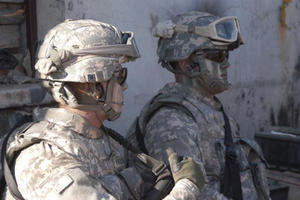In the trenchesNew helmets to make soldiers more alert, reduce stress, pain
New helmet to enhance U.S. soldiers’ cognitive abilities, improving long-term alertness, and reducing stress, anxiety, and pain; DARPA-funded research looking to equip helmets with noninvasive technology for “transcranial pulsed ultrasound,” which can remotely stimulate brain circuits

The helmet is under constant review and improvement // Source: llnl.gov
One of DARPA’s latest ideas has to do with a neurotechnology lab at Arizona State University that specializes in ultrasonic brain stimulation. By implementing the technology in soldiers’ helmets, DARPA hopes to provide advantages to U.S. troops by enhancing cognitive abilities, improving long-term alertness, and reducing stress, anxiety, and pain.
Armed with Science reports that the research lab is run by neuroscientist William Tyler, who has been investigating noninvasive approaches to brain stimulation for many years. Some of the applications of brain stimulation include treating neurological diseases such as Parkinson’s and depression, as well as enabling the development of brain-computer interfaces.
Tyler explains that two of the biggest challenges in brain stimulation are achieving high spatial resolution (for precise control of brain circuitry) and deep penetration (for reaching all parts of the brain). Currently, some brain stimulation techniques require surgically implanting electrodes to achieve these goals, and non-surgical techniques tend to lack in one or both areas. Tyler, however, has developed a noninvasive technique in which “transcranial pulsed ultrasound” can remotely stimulate brain circuits without the need for surgery. The pulsed ultrasound approach can provide a spatial resolution that is about five times greater than other non-surgical techniques and can reach deep-brain circuits to the same depth as surgical techniques.
With the new grant from DARPA, the lab is now turning its attention toward developing applications for U.S. soldiers. Instead of using the technology to repair damaged brain circuits, the researchers are exploring how ultrasound can affect healthy brain circuits. They have developed working and conceptual prototypes of ballistic helmets embedded with ultrasound transducers and microcontroller devices. One of the most important applications may be minimizing the effects of a traumatic brain injury (TBI), as Tyler explained to Wired.
“The really damaging part of a TBI isn’t the initial injury,” he said. “It’s the metabolic damage, the free radicals and the swelling that are happening in the hours afterward. If you can flick your remote and trigger an immediate intervention, you’d be curbing what might otherwise be lifelong brain damage.”
